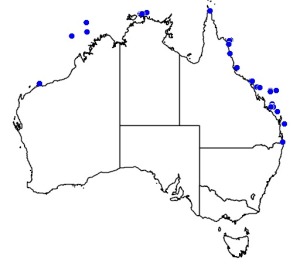�
�

©Lyle Vail and Anne Hoggett: The two smaller pale crinoids are Oligometra serripinna. The larger, more delicate crinoid that is partially visible on the right is Phanogenia mulitfidus.
�
���
Oligometra serripinna

©Lyle Vail and Anne Hoggett: The two smaller pale crinoids are Oligometra serripinna. The larger, more delicate crinoid that is partially visible on the right is Phanogenia mulitfidus.
Kingdom
Animalia
Phylum
Echinodermata
Class
Crinoidea
Order
Comatulida
Family
Colobometridae
Genus
Oligometra
Species
Oligometra serripinna
Colours
Distinguishing features
A flexible crinoid with only ten arms, usually quite small (arm length 30 to 60 mm) but sometimes larger (up to 140 mm). A good ring of short cirri and distinctive, serrated oral pinnules that are held inwards, covering the disc. Mottled or banded colour pattern with brown, cream and/or pale yellow.
Size
- Size data has not been obtained.
Depth range
- Depth range data is not yet available.
Synonyms
Distribution
Distribution and habitat preferences
Found all around the Lizard Island group, most commonly in areas of high current flow such as North Point. Exposed day and night, clinging to gorgonians and other narrow objects.
Web resources
References
References that assist with identification
- Clark, A.M. and F.W.E. Rowe (1971). Monograph of shallow-water Indo-west Pacific echinoderms British Museum (Natural History), London.
Other references
- Holland, N.D., A.B. Leonard and D.L. Meyer (2001). Digestive mechanics and gluttonous feeding in the feather star Oligometra serripinna (Echinodermata: Crinoidea), Marine Biology, 111: 113-119. LIRS catalog number 306.
- Holland, N.D., A.B. Leonard and J.R. Strickler (1987). Upstream and downstream capture during suspension feeding by Oligometra serripinna (Echinodermata: Crinoidea) under surge conditions, Biological Bulletin, 173: 552-556. LIRS catalog number 227.
- View all references








